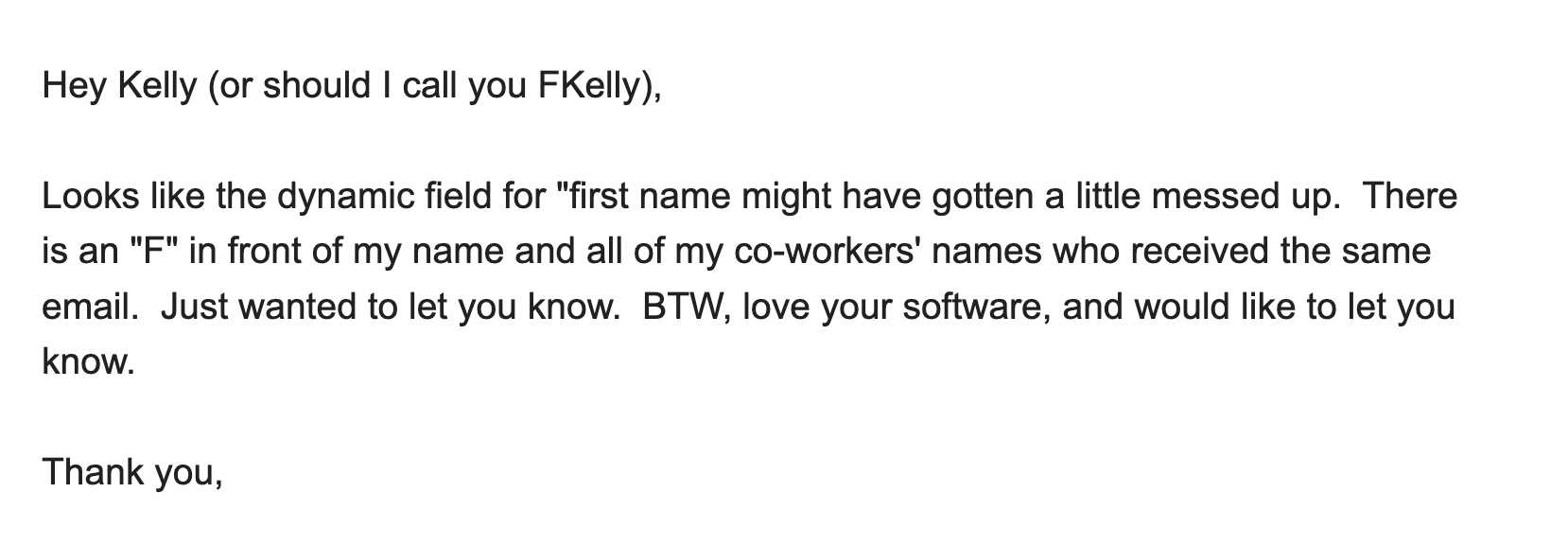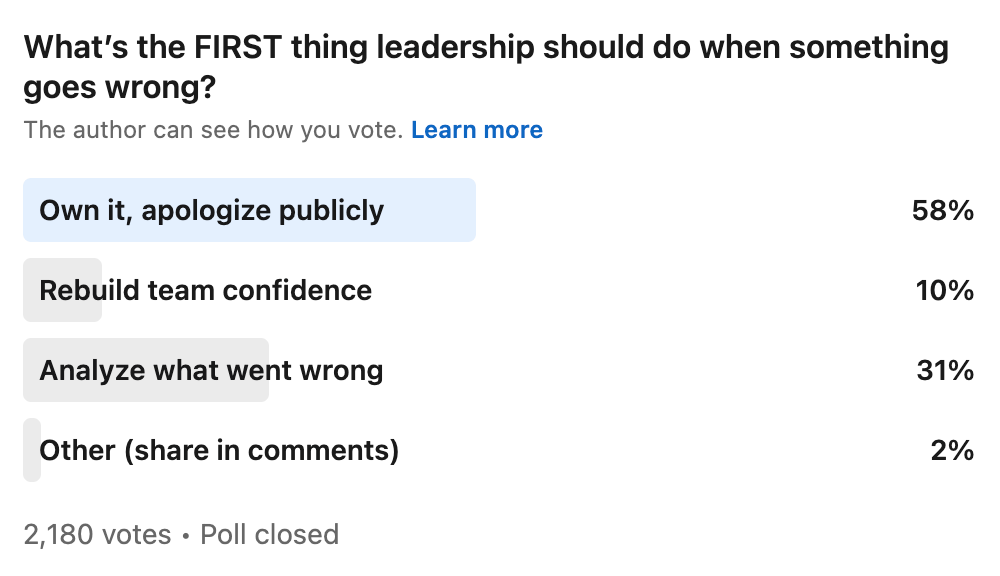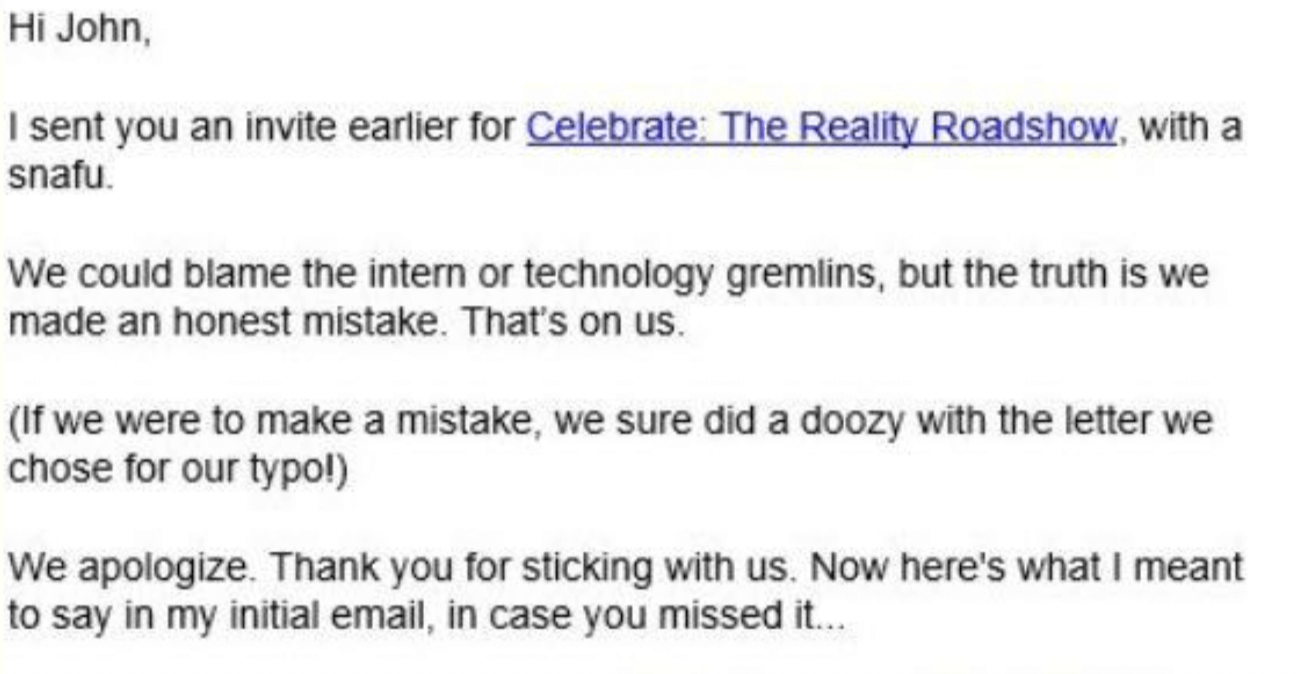
Mistakes happen – here’s what to do next
Ughhh….
My stomach dropped…
And my heart started racing.
I squinted and leaned in towards the computer to confirm my eyes were not failing me (they weren’t).
Even though I didn’t want to believe it… there it was:
A response to an email my team sent to key customers and prospects earlier that day.
Now, normally, small typos don’t ruffle me — but this reply was different:
It pointed out an unfortunate email snafu that we sent.
With me as the sender.
To 101,451 of our customers.
Yes, that’s A LOT of people.
Not exactly the vibe we were going for…
What happens next?
When mistakes happen (as they inevitably will), what we do next as leaders often leaves a lasting impression. On customers, prospects, AND employees.
It could be something as small as an email typo or a larger issue like your service unexpectedly going down. But when something doesn’t go as planned, what happens next?
How do you and other leaders at your organization react?
To gain a little insight into your opinions on the topic, we put out a poll on Gong’s LinkedIn page a few weeks ago to understand what you think.
Here’s what we found:
The majority agreed it’s best to own the mistake and apologize publicly.
Learning from our mistakes
Now, most of us would agree that we don’t learn without failure. These moments are life lessons. Mistakes happen. They just do. And growth is uncomfortable.
How are we creating a culture of learning, where we accept and learn from mistakes?
If you’re not failing every now and then, you’re probably holding your team back. People may be so scared of making a mistake that they refuse to take risks, stifling creativity and innovation. Striving for perfection may be getting in the way forward progress. Plus, think about how much learning comes from each mistake.
So, mistakes should and will happen.
However, the tone you set with your team around making mistakes matters more than you think.
So even if your stomach drops when you learn of an error or blunder, take a moment to breathe before jumping into action.
Honestly, when I learned of the email snafu, I was initially a bit stressed and embarrassed. But after a few moments to process, I realized this template error was just an innocent human mistake that anyone could have made. It was just an email typo.
These moments are not about teaching your team to chase perfection. Instead:
Embrace and normalize making mistakes.
As a leader, how do you help your team feel supported when something goes wrong?
There are many benefits of leaders admitting their mistakes: It earns respect. It strengthens the team. It allows you to lead by example. And, it builds trust.
At the end of the day, it’s all about the culture you’re building at your organization. Do you want a culture that accepts (and maybe even celebrates) mistakes? Or do you want to build a culture where employees are scared to act or admit missteps because they fear unpleasant consequences?
As a leader, you play a huge role in setting the tone. The organization is looking to you to understand what the unspoken reaction is when these sorts of mistakes happen.
Your 4 step action plan
Although the email snafu is a recent example of a slip-up, I’ve seen countless fumbles happen. Some leaders reacted to these fumbles masterfully in way that drove organizational learning and growth while taking care of the issue. In other cases, the leader’s response to the fumble became even more problematic than the initial mistake itself.
So, what’s the best way to get back on track? Here’s a 4 step plan for what to do when a mistake happens.
These are the steps I strive to follow (and encourage my team to abide by as well):
1. Own The Mistake
Take ownership of the misstep. Recognize and acknowledge that a mistake happened.
First, flag what happened to the appropriate internal teams who might be impacted. Let them know you’re aware of the issue and are working towards a remedy. This is all about communication and setting expectations with your team.
Taking ownership and responsibility for what happened is essential. Apologize. Acknowledge that a mistake was made. Don’t try to minimize it.
Mistakes happen. Owning the mistake and apologizing is the first step.
2. Assess The Damage
Now it’s time to take inventory.
Questions to consider:
- What’s the scope of the issue?
- How many people were impacted?
- How fast do we need to act?
This step is all about taking the time to uncover and understand what really happened. Where did things go wrong?
This is a critical step because it will inform the appropriate course of action. Two customers receiving an incorrect invoice is a lot different than thousands of customers facing an interruption of service.
Whatever you do, don’t play the blame game. While understanding the root of the problem is essential to prevent the mistake from happening in the future, pointing fingers won’t help solve the problem. Accountability and honesty are your friends.
3. Make It Right
This is where you spring into action. (Notice this isn’t the first item on the list.)
The “correct” actions will vary from situation to situation but here are some key tenets to consider:
How can you make it right?
Seek to understand how your mistake impacts those affected. Put yourself in their shoes. What will be the best approach to addressing and resolving the issue?
What’s the best next step? What’s the best communication strategy? What actions should you take? What remediation can you do? What changes do you have to implement?
Maybe you need to issue an apology. Maybe make a donation. Maybe provide reassurance that it won’t happen again.
All of these are options that should be considered depending on the severity of the issue and who was impacted by the mistake.
This is a moment for you to lean on your team and see them shine. They might have experience with crisis management and know exactly what to do next – if you hear them out. Listen to the experts you hired to build with a plan that will create raving fans.
For our email blunder, here’s how we owned the misstep:
Be human in your response. Honest. Authentic. Even vulnerable. People will appreciate the real personal touch much more than corporate and legal jargon.
4. Learn And Grow
This is the part where you reinforce the tone that mistakes are ok. Reiterate that mistakes can even be helpful with driving the organization forward.
It might mean sending a company- or org-wide email. It might mean addressing the situation at your next all-hands. It might mean forming a committee to take action. It might even mean dedicating a newsletter edition to the topic, like I am here.
The appropriate course of action will depend on the severity of the issue and the impact of the mistake. But even if it’s something that feels minor (especially when tempting to brush it under the rug and move on), I challenge you to leverage the opportunity for the organization to learn and grow. This is an occasion for you, as a leader, to set the tone on how your company responds to mistakes.
At Gong, we went as far as to share our mistakes (and what we learned) publicly. You can see Russell’s post on the situation, as it was his team who manages our email communications.
It was refreshing to see a high level of accountability, vulnerability, and even humor from a leader. (I think Russell’s ownership, humility, and tone contributed to why so many people connected with it.) Plus, this was a shining example to highlight to our Gongsters that mistakes, even though unfortunate, will happen and are truly accepted.
Take advantage of each mistake to positively impact your org’s culture and future business for the better.
If you have any lessons learned from mistakes you’ve experienced (big or small), I’d love to hear your stories too. Please do share in the comments.
Now that I’ve shared more of my journey, I can’t wait to learn and grow from yours.
Until next time,
Kelly



